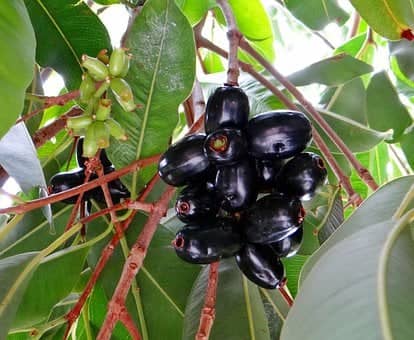Jamun trees can grow in the UK and farmers are already growing this exotic sweet and sour fruit in many regions of the United Kingdom. This content will help and guide you to grow jamun trees in the UK especially in garden backyards and in pots.
Quick overview – Yes, jamun tree grows in UK, it grows in tropical and subtropical regions, dwarf jamun trees can be grown in gardens.
Jamun tree overview
Syzgium cumini is the scientific name of jamun and it is commonly known as Java plum, malabar plum, black plum, jambul, blackberries or jambolan. It is an evergreen tropical tree in the flowering plant family Myrtaceae and is preferably grown for its fruit, medicinal value, timber and ornamental value.
Native – The java plum tree is native to the Indian subcontinent and Southeast Asia including Myanmar, Sri Lanka Bangladesh and the Andaman Islands. The tree was introduced to Florida. Syzgium cumini or jambolan tree has been introduced to the Islands of the Pacific and Indian Oceans, Australia, Hong Kong and Singapore.
Growing zone – It has edible exotic fruit that commonly grows in tropical and subtropical regions worldwide. It mostly grows in Southeast Asian countries. The tree also easily grows in the UK, Australia, the US and other European countries.
Fruit – It is a small cylindrical type of fruit. Unripe fruit looks green as it matures, its colour changes from green to pink to shiny crimson red and finally to dark violet-blackish colour while ripening. It has a juicy sweet and sour fruit containing many medicinal properties and hence has a huge demand in the medicinal industry.
Jamun fruits are eaten by native birds and small mammals such as jackals, civets and fruit bats. The Jamun tree starts flowering from March to April and the flowers contain a fragrance, they are small about 5 mm in diameter. The Jamun fruit grows from May to June and resembles large berries.
Tree height – These tropical subtropical trees are big in size and have thick trunks. They are tall trees and can reach a height of up to 30 m (100 ft) and have a life span of more than 100 years. There is also a dwarf Jamun tree variety that grows up to 5 to 9 feet only and can be maintained by a person through the trimming process. These trees are usually grown by gardeners in their backyard.
Uses – The tree is mostly grown for medicinal values, it is also grown for ornamental values. It is used in making cheap furniture. Due to rot resistance capacity jamun wood is used in railway sleepers and to install motors in wells.
Nutrition – Raw fruit – 83% water, 16% carbohydrates, 1% protein and very low fat. The raw fruit provides 60 calories in a 100 gram reference amount and a moderate content of Vitamin C.
Can Jamun tree grow in UK
Yes, one can easily grow jamun trees in their backyard. Yes, it is possible to grow small jamun trees at home and in the United Kingdom people are already doing the same. If you don’t have a sufficient backyard you can grow the tree beside your house or nearby house where you can care and trim it. Dwarf jamun trees reach heights up to 5 to 9 feet only and can be easily maintained by ordinary humans.
Jamun is propagated by seeds and plant cuttings. Vegetative methods are recommended over seed propagation because seeds usually take much more time in comparison to vegetative methods.
Spring and monsoon seasons are best for planting so you should plant it during pre-monsoon. Flowering takes place from March to April and fruit develops in my to June months. The Java tree grows well in tropical and subtropical regions and dry weather is good for the tree during flowering and fruit-setting time.
Planting Jamun tree
Jamun tree cultivation is done on a large scale. If you want to grow a jamun tree at home then a dwarf tree is suggested. Seeds and vegetative are popular propagation methods.
Growing jamun in a garden
- Select plant cutting from a healthy mother plant.
- Dwarf plants are already very small in size.
- Dig the pit of 45 cm and the depth should be nearly 3 inches.
- Spray the dig with neem spray and put some FYM.
- Then leave the dig open for 2 days in direct sunlight.
- It will kill all the small and bad insects.
- After 2 days, place the plant into the dig and level the mud beside it.
- Remember, don’t press the mud too hard; it will reduce air pockets.
- If air pockets are reduced then oxygen and water passing space will be reduced.
- If the plant does not get sufficient oxygen and water, it may collapse due to dryness.
- While planting the jamun plant in pots it is necessary to dig the soil in some intervals or whenever it seems tightened.
- Organic fertilizer is best for the plant and you can use neem cake spray as a pesticide to obtain the organic fruits in the garden.
Planting jamun in pots
- Collect some Jamun fruits and remove the pulp completely.
- Dry the seeds for a day or 2 days under sunlight.
- Select the seeds whose colour turns from white to brown.
- Use 50% normal garden soil, 20% sand soil and some organic compost in the pot.
- Select a pot having a draining system or dig a couple of small holes at the bottom of the pot.
- Now fill the ready soil mixture in the pot and sow the seeds.
- Germination occurs after 16 to 18 days and tiny plants can be viewed.
